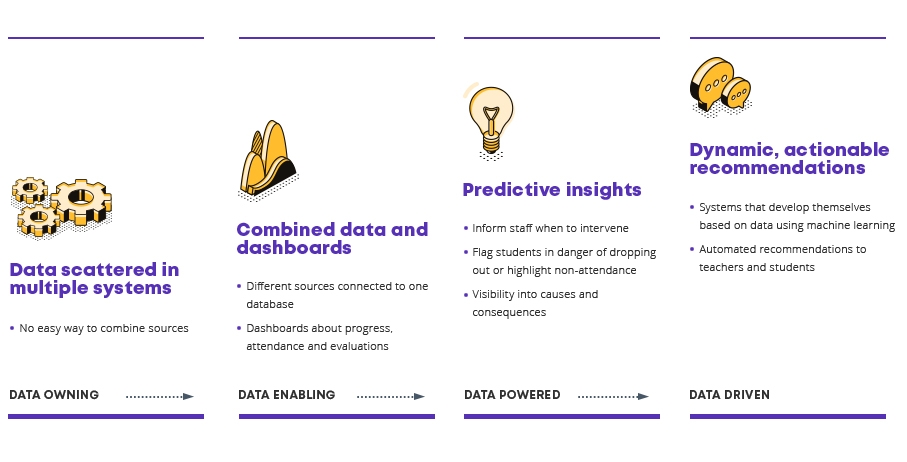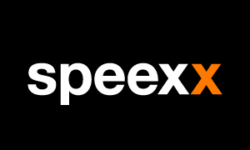Supporting learning with data is a process of using analytics to empower learning and making decisions based on data-backed evidence.
 Smart new technologies, such as machine learning and data mining have made significant progress in recent years, and their impact is growing in many areas of life. The finance sector is a prime example of how data and machine learning are used to optimise business processes. The field of finance naturally lends itself to data. It runs on clear metrics and has precise targets for optimisation.
Smart new technologies, such as machine learning and data mining have made significant progress in recent years, and their impact is growing in many areas of life. The finance sector is a prime example of how data and machine learning are used to optimise business processes. The field of finance naturally lends itself to data. It runs on clear metrics and has precise targets for optimisation.
Organisational learning, on the other hand, is an example of a field with varied goals and fuzzy data. That is the main reason, the area of learning has largely been lacking analytics and data-powered decision making. However, technological development is reaching a stage in which these obstacles can be overcome.
HR has a natural position to becoming a true leader in digital learning. This transition has started, and it will gain strength with time. The enabler, new technologies, and the driving force need for more effective learning require new ways of operating and managing data. The phases of the process and tools are described in Graph 1 and explained in the following text.

Graph 1. The phases of leading learning with data
Scattered data
The data is already here, but where exactly?
Most organisations already collect and hold massive amounts of learning related data. Digital platforms, online courses, tests, competence appraisals, self-reports, education feedback, and other similar systems produce a wealth of information. One of the key challenges is that data is located in multiple unlinked systems. To use this data, one needs to derive it from various sources and combine it manually. As a result, HR is left with periodically producing one-off reports with cross-sectional analyses about the current state of affairs.
Manual reporting, even if partially automated to reduce the amount of work, is not real-time. It focuses on a pre-selected set of explicit variables and is rudimentary and lacks the possibilities for insights compared to more present-day solutions.
Combined data and dashboards
Once an organisation combines its databases or builds interfaces for that purpose, more efficient data-enabled learning can begin to commence. Combining the learning management system, educational data, competency evaluations and performance data brings insight into how all of these relate to one another.
Ideally, this information is presented in a simple dashboard providing real-time analytics about learning and development. It can bring insights into where learners are spending time, what they are engaged in and what seem to be the evident obstacles for development. Correlating the educational variables with business results, such as sales data, provides ways to explore the progress and effects of specific programs or interventions.
For the most part, dashboards are still constrained with human deficiencies in decision making. They only show what they are planned to show. We are inclined to focus on the explicit relations between the most obvious variables. Many of the implicit reasons between causes and effects are hidden from a human investigator.
Predictive insights
Even with the ill-defined datasets related to learning and development, advancement in natural language processing and image recognition allow algorithms to make sense of contents and contexts in materials. That is, they can mine the data points for meaningful correlations that often escape the naked eye, such as finding relations between implicit, hidden variables, and draw on historical data and decisions within organisations. They lack some of the pitfalls compared to human decision making and can outperform even most experienced human practitioners.
These systems can be assigned to identify learners who are not participating, or whose skills are in danger of lagging behind. They can also highlight some of the knowledge gaps or strengths within an organisation. In parallel with helping HR professionals, the same algorithms can be harnessed to serve the learners. Indeed, the next level of learning systems is those that can make accurate recommendations for learners, educators, and HR.
Dynamic, actionable recommendations
Web stores and social media are effective in making interpretations about our interests and recommending us products or services that appeal to us. This same technology can be applied to support learning. This enables an organization to deliver truly tailored recommendations for ‘just-in-time’ learning and personalised training programs for each employee instead of fixed courses designed for the masses.
When a system has understanding about the needs, interests and learning activities of employees, it has a robust set of data to conclude from. It can be recommend materials, activities and interactions to a specific learner based on identified needs. Further on, a learning platform can make accurate recommendations for future learners about which actions would be beneficial for them based on previous learners’ activities.
The next developments in this process will be automated learning paths using materials inside an organisation and automatically providing appropriate tests to measure learning and motivation.
Conclusions
Digitalisation and data are not solutions to every problem. Leading with data is about developing new ways of operating. It is slow; it requires work and most of all, it requires a comprehensive understanding of current operations. The first step is recognising the current state of learning data in an organisation and designing the steps to take the process forward.
Data-driven systems do not replace effective competence management, but HR professionals that refuse to leverage available data for this purpose will be replaced by those who do.
Writer details:
Topi Litmanen PhD
Chief Educational Scientist
Claned
topi@claned.com
+358503779890
